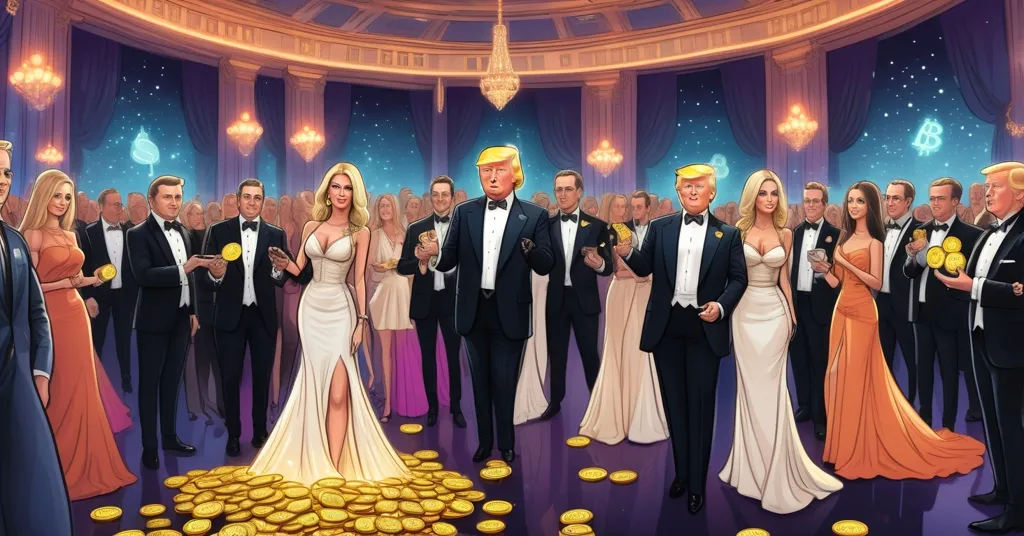Trump’s Crypto Push: Gala for $TRUMP Holders, Truth.Fi ETFs, and Stablecoin Plans Unveiled

Trump’s Bold Move: Gala for $TRUMP Holders and Expansion of Crypto Strategy
Donald Trump is diving headfirst into the world of cryptocurrency with a strategy that includes hosting a gala for $TRUMP holders, launching Truth.Fi ETFs, and backing a new stablecoin project, aiming to position the U.S. as a “crypto capital.”
- Gala for $TRUMP holders on May 22
- Launch of Truth.Fi ETFs
- Executive orders on digital asset regulation
- Strategic bitcoin reserve established
- Backing a new stablecoin project
The Exclusive Gala
On May 22, the Trump National Golf Club in Sterling, Virginia, will host an exclusive gala for the top 220 holders of the $TRUMP meme coin. The top 25 will receive a private tour and VIP reception, a perk that sent the $TRUMP coin soaring by over 50% to $14.70 before settling at $12.30. This isn’t just a party; it’s a strategic move to engage directly with the crypto community, which Trump is betting big on. If you’re one of the top $TRUMP holders, get ready for a gala that’s more exclusive than a VIP section at a Trump rally.
What’s more, attendees must hold their $TRUMP tokens until May 12 to secure their spot. In the event of Trump’s absence, attendees will receive a limited-edition Trump NFT as a consolation prize. This event underscores Trump’s commitment to leveraging meme coins to engage with the crypto community, though the long-term impact of such strategies remains to be seen.
Truth.Fi ETFs: A New Era
In a blend of politics and finance, Trump Media & Technology Group (DJT) has partnered with Crypto.com to launch Truth.Fi ETFs. These Exchange Traded Funds (ETFs), set to debut later this year pending regulatory approval, will focus on “Made in America” crypto assets, including Bitcoin and Cronos (CRO). This initiative signals Trump’s intent to integrate digital assets into the U.S. financial ecosystem, normalizing cryptocurrencies in traditional markets. Can a gala and ETFs really move the needle on crypto adoption?
The launch of these ETFs not only aims to provide investors with diversified exposure to cryptocurrencies but also positions the U.S. as a leader in the digital asset space. However, critics argue that such moves could be seen as an attempt to influence market dynamics for personal gain, given Trump’s involvement in the crypto market.
Regulatory Shifts
In January 2025, Trump signed an executive order encouraging digital asset regulation, opposing Central Bank Digital Currencies (CBDCs), and promoting U.S. dollar-backed stablecoins. This order also established a working group to propose a regulatory framework and evaluate creating a national digital asset stockpile, including a strategic bitcoin reserve—a government-held stash of bitcoins aimed at stabilizing the economy. Trump’s comprehensive approach aims to make the U.S. the “crypto capital” of the world.
The opposition to CBDCs is a significant aspect of Trump’s strategy, as he believes they could undermine the financial sovereignty of the U.S. By promoting U.S. dollar-backed stablecoins, Trump is pushing for a digital currency system that remains tied to the traditional financial system, which could have profound implications for global finance.
Stablecoin Ambitions
Further showing his commitment, Trump and his sons are backing a stablecoin project under World Liberty Financial, set to launch on Ethereum and Binance Smart Chain. This aligns with his executive order’s focus on stablecoins, signaling a move towards mainstream financial use of digital assets.
Under Trump’s administration, the Securities and Exchange Commission (SEC) has paused lawsuits against Binance and formed a “Crypto 2.0” task force to develop a clear regulatory framework for cryptocurrencies. These actions reflect a shift towards a more permissive regulatory environment, facilitating easier access to banking services for crypto companies—a stark contrast to the previous administration’s restrictions.
However, not everything about Trump’s crypto strategy is being celebrated. Critics have raised concerns about potential conflicts of interest, particularly with Trump and his family’s involvement in cryptocurrency ventures. The Guardian reported accusations of “shameful” conflicts of interest, pointing to the involvement in meme coins and the stablecoin project as areas of concern.
Despite these controversies, Trump’s strategy blends politics, finance, and market speculation. The announcement of the gala and the ETFs has positively impacted investor sentiment, as evidenced by the rise in DJT shares and the $TRUMP coin’s value. Yet, the long-term impact on mainstream adoption of digital assets remains uncertain, especially given the volatility and speculative nature of meme coins.
The global trend towards digital finance is undeniable, and Trump’s aggressive, industry-friendly approach positions the U.S. as a leader in this space. However, the potential risks beyond conflicts of interest, such as increased market volatility and fraud due to deregulation, cannot be ignored. The disbanding of the DOJ’s fraud unit could exacerbate these risks, making it crucial to balance innovation with oversight.
As Trump continues to push the boundaries of cryptocurrency integration into national policy, the world watches with a mix of optimism and caution. Will his strategy pave the way for a new era of digital finance, or will it lead to unforeseen challenges?
Key Takeaways and Questions
- What is Trump’s crypto strategy?
Trump’s crypto strategy involves hosting events for meme coin holders, launching crypto ETFs, establishing a strategic bitcoin reserve, and backing a stablecoin project, aiming to integrate digital assets into U.S. financial and regulatory frameworks.
- How is Trump engaging with the cryptocurrency community?
Trump is engaging by hosting a gala dinner for top $TRUMP holders and launching initiatives like Truth.Fi ETFs and a stablecoin project, blending political influence with market dynamics.
- What legislative actions has Trump taken regarding cryptocurrencies?
Trump signed executive orders encouraging digital asset regulation, opposing a CBDC, and establishing a strategic bitcoin reserve alongside a broader digital asset stockpile.
- What potential risks are associated with Trump’s direct involvement in crypto projects?
The primary risk is the potential for conflicts of interest, as Trump’s involvement in crypto projects could influence policy decisions for personal financial gain.
- How might Trump’s crypto strategy impact the mainstream adoption of digital assets?
By launching ETFs and backing stablecoin projects, Trump’s strategy could help normalize digital assets in traditional markets, though the long-term impact remains uncertain.



